#paul d. kelly
Explore tagged Tumblr posts
Text
Training montage from The Cutting Edge (1992)
#couldn't be bothered to cut out terry o'quinn at the end#song is “Ride On Time” by Black Box#The Cutting Edge#training montage#montage#video#90s movies#1990s film#1992#moira kelly#terry o'quinn#sports movie#paul michael glaser#d.b. sweeney#db sweeney#d b sweeney
2 notes
·
View notes
Text

Rita Hayworth-Frankie Darro-Paul Kelly "Juvenile Court" 1938, de D. Ross Lederman.
17 notes
·
View notes
Text


Calgarians invited to an evening
with Paul Gross
I doubt it will be recorded 😔
Info 9.17.2024
I received the response from Arts Commons, this event will not be broadcast or recorded 🥺
CTV article
#Si vous avez la chance d être à Calgary fin septembre ! Faites moi des photos de qualité au minimum !#If you are lucky enough to be in Calgary at the end of September! Take some quality photos for me at least!#paul gross#paulgross#paul gross interview#the Seafarer#artscommons#Dave Kelly#alberta theatre projets
0 notes
Text
The Cutting Edge (1992)

As far as formulaic romantic comedies go, you could do far worse than The Cutting Edge. The leads are appealing and the sports angle does add a bit of zip to the recipe… but at the end of the day, it’s still a formulaic romantic comedy. You can predict every beat of this story minutes in.
Kate Moseley (Moira Kelly) is a spoiled but talented figure skater whose attitude has driven away every one of her partners. Doug Dorsey was the captain of the U.S. ice hockey team until a head injury forced him to retire and killed his olympic dreams. When Kate’s coach, Anton Pamchenko (Roy Dotrice) decides to recruit the former hockey star as Kate’s partner for the upcoming 1992 Olympics, it looks like a bad idea. They clash constantly. They can’t stand each other… but their animosity means neither will be the first to quit.
I should let you write the rest of this review. Do I have to tell you that Doug is a ladies’ man, that Kate is engaged to a man she has nothing in common with, that a turning point in the story has her breaking off her engagement to try and seduce Doug but that when she goes to apologize to him the next morning she finds him in bed with a rival skater, prompting a big argument? That’s all obvious, as are the reasons why they don’t initially get along. Kate is a prima donna who considers hockey a sport for oafs. Doug thinks figure skating is for girls and is embarassed to admit what he’s doing to his older brother. Of course. Is there any other way they could behave? Not in these types of movies.
Once the initial friction subsides and the pair begins competing to attend the Olympics, things don’t get any less conventional. Even when the movie tries to fool you into thinking it’ll do the unexpected, you know better. For crying out loud, the way characters are introduced or what they look like tells you exactly what part they’ll play in this story.
Following a formula doesn’t necessarily make a bad movie but this film isn’t an early example of the rom-com genre; it came out in 1992 when we were far too familiar with the tropes to be satisfied with the basics once again. That said, there is a certain charm to this tried-and-true formula. I couldn't hate the movie because it doesn’t do anything badly. Usually, these plots have to jump through all sorts of contrived hoops to go the way they do and this one does not. It’s a lot more grounded than expected. There is also the appeal of seeing well-performed figure skating routines shot from the perfect angle, featuring people we actually know. This keeps you invested enough to keep watching despite knowing well in advance what the ending will be.
The worst thing about The Cutting Edge is that it’s basic. This is the sort of movie you’d see as a kid or young teen and enjoy. For years, you'd be dumbfounded, wondering why others don’t share the same enthusiasm for it that you do. Over the years, you’d realize why. This has all been done before and better. For that reason, I can’t recommend The Cutting Edge, but it’s a near miss. (On DVD, October 3, 2021)

#The Cutting Edge#movies#films#movie reviews#film reviews#Paul Michael Glaser#Tony Gilroy#D. B. Sweeney#Moira Kelly#Roy Dotrice#terry O'Quinn#1992 movies#1992 films
0 notes
Note
just want to second a recent ask and say that i too LOVE the silly little bonus polls, please create as many of them as your heart desires and i will gleefully clicky the buttons :D
oh ok! good! yay!
662 notes
·
View notes
Text
The thing about the second lava monster encounter in Master of the Mountain that gets me is it feels like a failed perception check. Like the entire season gives the vibes of the writers (and possibly voice actors) deciding to play D&D as Cole, Vania, and Wu then deciding to add Plundar, Fungus, and Korgran to the party later but dear lord, that scene gives the vibes of Kirby responding to Sabrina in character as Cole and whoever is the DM saying "roll for perception" and Kirby rolling a 1.
Like I literally feel like the writers and voice actors were playing a Ninjago themed campaign for the sake of Master of the Mountain having the vibes it does and they get to that point and have this exchange.
Sabrina, in character as Vania: Wait, Cole! The lava monster! What if it's still in the cave waiting for us?! Kirby, in character as Cole: What, just sitting there, staring at a wall? DM: Roll for perception. Kirby: SHIT.
Additionally I love the idea that they just went nuts with this because the shenanigans Wu, Vania, and Cole get into with the Upply feels like a D&D campaign.
Ian, in character as Fungus: Korgran, a little help. DM: Paul, roll for performance. Paul: ...it's a 1. DM: You run into the door, falling on the ground. Your axe falls to the ground with a clatter. Paul, in character as Wu: The door will only open for a those who are one with the Earth -- an Earth elemental. -- Adam Trask, in character as Plundar: I want to steal one of Cole's weapons while he's unconscious. DM: Roll for sleight of hand. Adam: It's a 10. DM: You successfully steal one of Cole's throwing stars while Cole's unconscious, but Fungus notices and tells you to return it when he introduces you to Cole. Adam: Damn. -- Kirby, in character as Cole: Well, we can't stop the Skull Sorcerer and save our friends trapped down here, can we?! DM: Kirby, roll for intimidation. Kirby: ...it's a 1. DM: You fail to at all intimidate Plundar, who gives you a half exasperated, half tired stare while Korgran watches you fight with Plundar with a mildly terrified expression.
Even the beginning of the season feels like failed or hilariously successful rolls.
Michael, in character as Jay: Direbats aren't a real thing! DM: Roll for history. Michael: ...1. DM: Immediately after saying direbats aren't a real thing, one picks you up and takes you off the Destiny's Bounty. -- Kirby: I'd like to persuade the Geckles and Munce to start a truce so we can get out of the mines. DM: Roll for persuasion. Kirby: It's a 4. DM: You manage to persuade the first few Geckles to meet for a peaceful truce meeting, but due to a game of broken telephone, a fight breaks out. Lloyd had the same amount of luck with the Munce. Kirby: Dammit. -- Vincent, in character as Kai: We aren't skeletons! DM: Roll a persuasion check. Vincent: 5? DM: The Geckles aren't convinced, referring to you as "fleshy skeletons" despite your clarifications. They decide to take you to their leader just to be sure. *later* DM: After discovering you are not, in fact, skeletons, the Geckles decide to make Kai their new chancellor to make up for their transgressions. Vincent and Brent, in unison: Wait what -- Kelly, in character as Nya: I fight Murtessa over Jay. *Kelly proceeds to ace all her skill checks* DM: You manage to knock down Murtessa, triggering an old Munce rite of ritual. You are now queen of the Munce. Kelly, Sam, and Michael in unison: WHAT?
#lego ninjago#ninjago#ninjago season 13#ninjago master of the mountain#YOU CANT CONVINCE ME THEY DIDNT PLAY D&D TO DEVELOP THE D&D SEASON.#IT JUST FEELS LIKE THEY TURNED A D&D CAMPAIGN INTO A SEASON LMAO.
151 notes
·
View notes
Text
Why Trump’s Arlington controversy is actually a crime
John Stoehr
August 30, 2024 5:49AM ET

Sgt. Phillip J. Reddick plays taps in honor of Staff Sgt. Darryl D. Booker and Col. Paul M. Kelly Nov. 16, 2013, at their Arlington National Cemetery grave sites (Photo by Virginia Guard Public Affairs)
It’s not a controversy. It’s a crime.
If we don’t say so, we’re complicit.
National Public Radio reported Tuesday that two officials from the Donald Trump campaign assaulted a staff member at Arlington National Cemetery. The staffer tried stopping the former president from filming a campaign advertisment in Section 60. That section is reserved for the men and women who died fighting in Iraq and Afghanistan. It’s considered by many Americans to be sacred ground.
Trump was at Arlington Monday for an event marking the third anniversary of an attack on US military forces as they withdrew from Afghanistan. An emerging theme of his presidential campaign is blaming Joe Biden and Kamala Harris for the 13 Marines who were killed that day by an ISIS suicide bomber outside Kabul Airport.
Later, at the behest of two Gold Star families, Trump attended a separate, private ceremony in Section 60 at the headstones of Marine Staff Sgt. Taylor Hoover and Marine Sgt. Nicole Gee. That’s when the “altercation” occurred. “When entering Section 60, campaign staff verbally abused and pushed the official aside,” according to NPR.
Assault is a crime, but the criming didn’t stop there.
ALSO READ: Trump campaign targets secretary of the Army in its latest attack over Arlington scandal
According to Arlington National Cemetery, it’s against federal law to make campaign advertisements in Section 60. In other words, it’s illegal to turn the honored war dead into disposable partisan props. Put another way, profaning their memory and sacrifice is punishable by law. In a statement to NPR, Arlington National Cemetery said:
“Federal law prohibits political campaign or election-related activities within Army National Military Cemeteries, to include photographers, content creators or any other persons attending for purposes, or in direct support of a partisan political candidate's campaign.”
In the same statement, Arlington National Cemetery said it “reinforced and widely shared this law and its prohibitions with all participants.”
Compounding the offense is the Trump campaign’s reaction.
Spokesman Stephen Cheung accused the cemetery staffer who was trying to uphold federal law of physically blocking “members of President Trump's team during a very solemn ceremony,” even saying the staffer was “clearly suffering from a mental health episode.” Another campaign official called the staffer “a despicable individual.”
Compounding matters more is the treatment of the Gold Star families.
They chose to invite Trump to the memorial, but did they also choose to be complicit in a federal crime? Did the Trump campaign inform them of the law, as Arlington had informed the Trump campaign?
According to Arlington National Cemetery, it informed “all participants.” Were the families led to believe they were merely helping a candidate whom they clearly support? Or were they led to believe law-breaking was fine and dandy as long as they were with Trump?
It gets worse.
The Trump campaign appears to have induced these Gold Star families into issuing a press release in which they thanked Trump and said they authorized his videographer to take photos and video at the ceremony.
There are two problems: One is that permission wasn’t theirs to give. Two is that there’s another headstone in the campaign photo (above). Army Master Sgt. Andrew Marckesano, a Green Beret and a Silver Star recipient who served six tours in Afghanistan, is buried next to Hoover. According to reports, his family wasn’t asked for permission.
So not only do these Gold Star families appear complicit in breaking federal law, they appear complicit in gravely offending another Gold Star family whose child loved his country as much as theirs did.
And by inducing these families into issuing their press release, he involved them indirectly in a cover-up of the original crime.
It gets even worse.
The Timesreported that the cemetery staffer who was assaulted for trying, under law, to stop the Trump campaign has decided not to press charges. Why? According to military authorities, the Timessaid, it’s because “she feared Mr. Trump’s supporters pursuing retaliation.”
In other words, she feared political violence.
So, thanks to Trump’s corruption, these Gold Star families now appear complicit in: breaking federal law; gravely offending another Gold Star family; covering up the original crime; and demonstrating the role of political violence in the wholesale degradation of individual liberty and the rule of law.
Their kids died fighting terrorism and terrorism won.
But they are not the only ones complicit.
So are we – if we don’t stand by what we say.
Arlington National Cemetery is operated by the United States Army. It is not a civilian bureaucracy run by a partisan appointee. There’s no “deep state” here. These are people with the deepest feeling imaginable for fidelity and respect. If anything, they’re Trumpsupporters. Yet loyalty to him didn’t override loyalty to the fallen. The obligation to their memory compelled them to oppose Trump’s desecration of it.
If we believe what we say about Arlington National Cemetery, and I think most of us do, there should be no debate over Monday’s events. There should not be “both sides.” This should not be a story about what Trump said versus what Arlington National Cemetery said. The question: shouldn’t be what happened? It should be: who do we believe?
Do we believe Trump, a draftdodger who thinks volunteers for military service are “suckers” and “losers”; who thinks soldiers maimed in combat are embarrassing; who said prisoners of war are unworthy of reverence; who insulted recipients of the Congressional Medal of Honor; and who, just yesterday, released an ad using the honored war dead as a disposable campaign prop to attack his opponent?
Or do we believe those trying to keep sacred ground sacred?
As I’m writing, the Post reported that the Army stands by the cemetery staffer who tried stopping the Trump campaign’s criming. The rest of us should stand by her, too. If we believe what we say about Arlington — and our values – there’s no question about what happened.
It’s not a controversy. It’s a crime.
We should say so.
28 notes
·
View notes
Text
list of songs hyunjin has played on his lives/recommended:
note: im probably missing some & i couldn’t put links to all of them cause apparently tumblr has a link limit 🤨
lauv: julia, lonely eyes, invisible things, paris in the rain, never not, im so tired, the story never ends, i like me better
offonff: photograph, cigarette (ft. miso & tablo), dance, bath
beyoncé: crazy in love (remix)
billie eilish: i love you, &burn, idontwannabeyouanymore, ocean eyes, before i go, tv
honne: day1, la la la that’s how it goes
christina perri: a thousand years
shawn mendes: mercy, treat you better, in my blood
dvwn: phobia
dpr live: jam & butterfly
jehwi: dear moon
leehi: rose
bts: dna, waste it on me, make it right
colde: where love begins, string (ft. sunwoojunga), the museum, wa-r-r, your dog loves you (ft. crush), control me, a song nobody knows, im in love
got7: miracle, hard carry
justin bieber: lonely
josef salvat: call on me
taemin: criminal
night off: sleep
sam kim: make up (ft. crush), like a fool, sunny days summer nights
niki: lowkey
iu: the visitor, lullaby, knees, love poem, give you my heart, my sea
cha ni: starlight
sia: snowman
akmu: happening
sunwoojunga: run with me
the black skirts: everything
korea cracker: ocean (ft. hoyeon kim)
cosmic boy: can i love?
penomeco: no.5 (ft. crush)
yerin baek: blooming memories, limit
10cm: so…., however
day6: i’ll try, love me or leave me, when you love someone, you were beautiful, congratulations, zombie, days gone by, afraid
dean: d (half moon), instagram, what 2 do, bonnie & clyde
exo: first snow, the eve, love shot
sam fischer: this city
jukjae: do you want to walk with me?, lullaby
ph-1: nerdy love (ft. yerin baek), as i told you
baekhyun: love again, un village
amine: blackjack
young k: come as you are, guard you
flume: say it (ft. tove lo)
twice: dance the night away, fancy
ariana grande: thank u, next
hajin: we all lie
about: it has to be you
caroline says: winter is cold
h.e.r: u, wait for it
bol4: to my youth
monday kiz: winter is as i wished
paul kim: the road, additional
sweden laundry: the winter
jung seung hwan: in that winter
chungha: gotta go
zion.t: no make up, snow
airman: gloomy star, i’ll be your spring (ft. j_ust)
motte: dont run away
seventeen: a-teen, super
khalid: location
lukas graham: 7 years
imagine dragons: believer
bo kyung kim: dont think you are alone
jung ilhoon: spoiler (ft. babylon)
davichi: falling in love, 이 사랑
coldplay: everglow, viva la vida
lyn: my destiny
jus2: focus on me, long black, senses (jpn version)
crush: beautiful, you and i
ed sheeran: lego house, perfect, photograph, beautiful people
croosh: why
20 years of age: x
tori kelly: paper hearts
seulgi: always
luna: do you love me? (ft. george)
wisue: someone’s shining
epik high: eternal sunshine
jp saxe: if the world was ending
seori: fairy tale
bruno mars: marry you
the weeknd: earned it, die for you
jung seunghwan: its raining, an ordinary day, dear
sam tinnesz: play with fire
post malone: motley crew
jihyo: stardust love song
kim feel: your voice
sung sikyung: solar system, heejae
younha: stardust
wonpil: a journey
taeyeon: invu, some nights, toddler, drawing our moments
nct dream: boom
ha hyunsang: 3108
huhgak: memory of your scent
se so neon: nan chun, a long dream, midnight train, stranger
umi: remember me
tvxq!: mirotic
johnny balik: honey
red velvet: psycho
new jeans: hype boy
christian kuria: losing you
cigarettes after sex: k. , each time you fall in love, sunsetz, apocalypse
dpr ian: nerves, no blueberries, 1 shot
samm henshaw: broke
woodz: drowning
kelly clarkson: underneath the tree
kimmuseum: to you who cant sleep
taylor swift: betty
lana del rey: young and beautiful
harry styles: watermelon sugar, she
pink sweat$: honesty
masego: tadow
olivia rodrigo: vampire
troye sivan: youth, for him
kai: mmmh
2pm: my house
oasis: wonderwall, hey now
mac miller: that’s on me, everybody
nothing but thieves: amsterdam
bren joy: sweet
back number: i love you
mac ayres: next to you, roses
daniel caesar: blessed, ocho rios, get you (ft. kali uchis), take me away (ft. syd), do you like me?, disillusioned
green day: dilemma
puma blue: already falling
bruno major: nothing, easily, places we won’t walk, the most beautiful thing, old soul
#hyunjin song recommendations#<- so i can find it later for updates#i spent like 3 hours writing this and putting the links shdjdndb#maybe anon from yesterday finds this helpful!
140 notes
·
View notes
Text
🌈 Queer Romances to Love All Year Round
🦇 Good morning, my beloved bookish bats. We're halfway through pride month, but there are still so many amazing queer books to read! To celebrate that love is love mentality, here are 78 queer romance novels you can add to your tbr! Don't forget to #readqueerallyear, and that none of us are free until all of us are free. 💜
❤️ Delilah Green Doesn’t Care - Ashley Herring Blake 🧡 Skye Falling - Mia McKenzie 💛 The Breakup Lists - Adib Khorram 💚 Prince of the Palisades - Julian Winters 💙 Solomon’s Crown - Natasha Siegel 💜 The Borrow a Boyfriend Club - Page Powars
❤️ Full Shift - Jennifer Dugan 🧡 A Shore Thing - Joanna Lowell 💛 Showmance - Chad Beguelin 💚 Exes & Foes - Amanda Woody 💙 Full Disclosure - Camryn Garrett 💜 When You Were Everything - Ashley Woodfolk
❤️ Playing the Palace - Paul Rudnick 🧡 I’m So (Not) Over You - Kosoko Jackson 💛 When Katie Met Cassidy - Camille Perri 💚 Captive Prince - C. S. Pacat 💙 The Lovers - Rebekah Faubion 💜 That Summer Feeling - Bridget Morrissey
❤️ Wild Things - Laura Kay 🧡 Experienced - Kate Young 💛 Lose You to Find Me - Erik J. Brown 💚 The Lesbiana’s Guide to Catholic School - Sonora Reyes 💙 Nate Plus One - Kevin van Whye 💜 Countries of Origin - Javier Fuentes
❤️ The Passing Playbook - Isaac Fitzsimons 🧡 But How Are You, Really - Ella Dawson 💛 Looking for a Sign - Susie Dumond 💚 The Prospects - KT Hoffman 💙 Last Night at the Telegraph Club - Malinda Lo 💜 Malice - Heather Walter
❤️ You Should See Me in a Crown - Leah Johnson 🧡 Let’s Talk about Love - Claire Kann 💛 Bonds of Brass - Emily Skrutskie 💚 Looking for Love in All the Haunted Places - Claire Kann 💙 The Stars and the Blackness Between Them - Junauda Petrus 💜 In Charm’s Way - Lana Harper
❤️ Everything Leads to You - Nina LaCour 🧡 Marriage of a Thousand Lies - SJ Sindu 💛 I Think I Love You - Auriane Desombre 💚 Lavash at First Sight - Taleen Voskuni 💙 The Bump - Sidney Karger 💜 The Disenchantment - Celia Bell
❤️ The Dos and Donuts of Love - Adiba Jaigirdar 🧡 Riley Weaver Needs A Date To The Gaybutante Ball - Jason June 💛 Epically Earnest - Molly Horan 💚 Out of the Blue - Jason June 💙 Flip the Script - Lyla Lee 💜 Imogen, Obviously - Becky Albertalli
❤️ Café Con Lychee - Emery Lee 🧡 A Little Bit Country - Brian D. Kennedy 💛 Late to the Party - Kelly Quindlen 💚 The Key to You and Me - Jaye Robin Brown 💙 What If It’s Us - Becky Albertalli & Adam Silvera 💜 The Falling in Love Montage - Ciara Smyth
❤️ The Love Curse of Melody McIntyre - Robin Talley 🧡 Meet Cute Diary - Emery Lee 💛 Love & Other Natural Disasters - Misa Sugiura 💚 Date Me, Bryson Keller - Kevin van Whye 💙 Just Your Local Bisexual Disaster - Andrea Mosqueda 💜 Pumpkin by Julie Murphy
❤️ She Gets the Girl by Rachel Lippincott - Alyson Derrick 🧡 Home Field Advantage - Dahlia Adler 💛 The (Un)Popular Vote - Jasper Sanchez 💚 Melt With You - Jennifer Dugan 💙 Cool for the Summer by Dahlia Adler 💜 Hani and Ishu’s Guide to Fake Dating - Adiba Jaigirdar
❤️ I Kissed Shara Wheeler - Casey McQuiston 🧡 Jay’s Gay Agenda - Jason June 💛 Triple Sec - TJ Alexander 💚 Finally Fitz - Marisa Kanter 💙 I’ll Be the One - Lyla Lee 💜 This Is Kind of an Epic Love Story - Kacen Callender
❤️ May the Best Man Win - ZR Ellor 🧡 One Last Stop - Casey McQuiston 💛 Late Bloomer - Mazey Eddings 💚 The Fiancee Farce - Alexandria Bellefleur 💙 Stars Collide - Rachel Lacey 💜 Truly, Madly, Deeply - Alexandria Bellefleur
#queer#queer books#pride#pride month#queer romance#read queer all year#sapphic books#sapphic romance#gay books#gay romance#wlw romance#bi books#bisexual romance#batty about books#battyaboutbooks
20 notes
·
View notes
Text
(Mostly) Lost, but Not Forgotten: Omar Khayyam (1923) / A Lover’s Oath (1925)




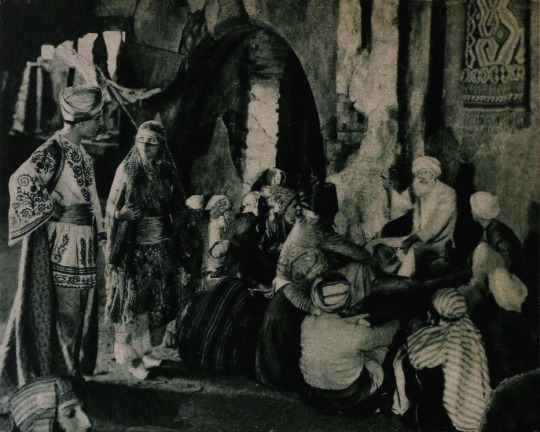

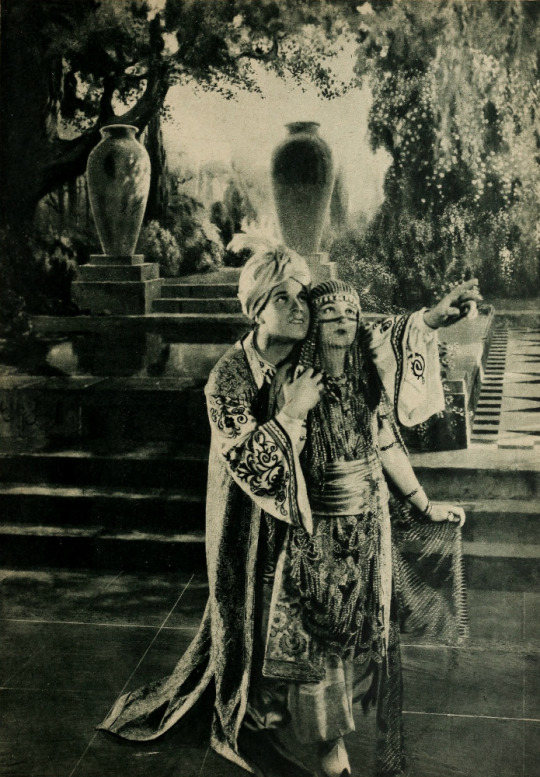
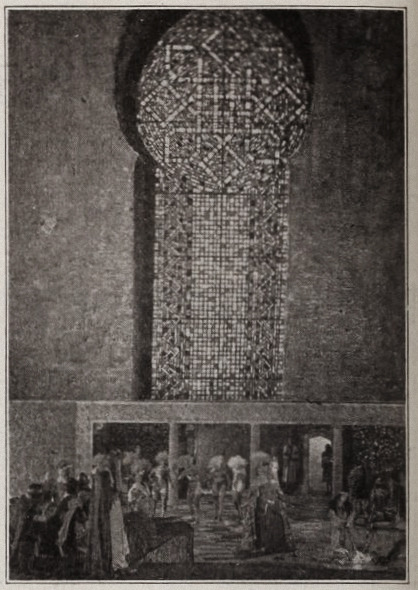
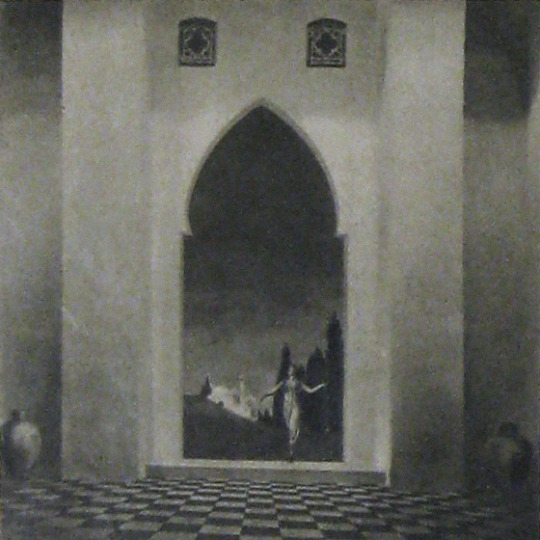
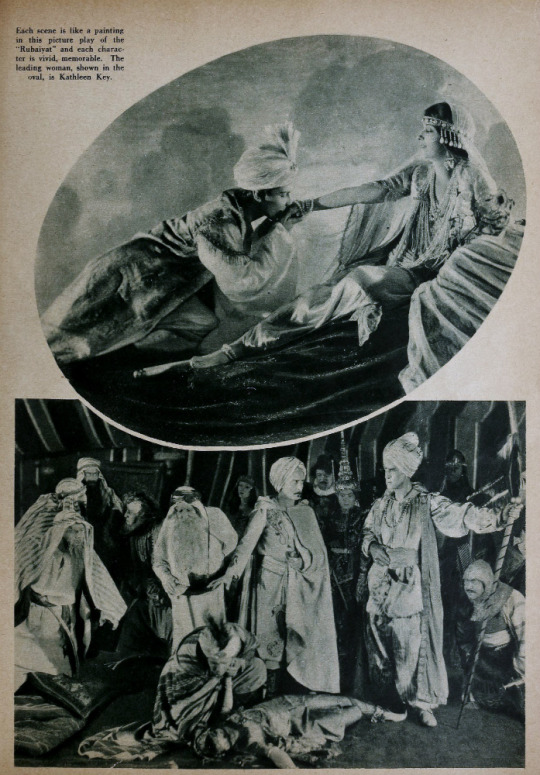



Alternate Titles: The Rubaiyat of Omar Khayyam, The Rubaiyat, Omar Khayyam, Omar
Direction: Ferdinand Pinney Earle; assisted by Walter Mayo
Scenario: Ferdinand P. Earle
Titles: Marion Ainslee, Ferdinand P. Earle (Omar), Louis Weadock (A Lover’s Oath)
Inspired by: The Rubaiyat of Omar Khayyam, as edited & translated by Edward FitzGerald
Production Manager: Winthrop Kelly
Camera: Georges Benoit
Still Photography: Edward S. Curtis
Special Photographic Effects: Ferdinand P. Earle, Gordon Bishop Pollock
Composer: Charles Wakefield Cadman
Editors: Arthur D. Ripley (The Rubaiyat of Omar Khayyam version), Ethel Davey & Ferdinand P. Earle (Omar / Omar Khayyam, the Director’s cut of 1922), Milton Sills (A Lover’s Oath)
Scenic Artists: Frank E. Berier, Xavier Muchado, Anthony Vecchio, Paul Detlefsen, Flora Smith, Jean Little Cyr, Robert Sterner, Ralph Willis
Character Designer: Louis Hels
Choreography: Ramon Novarro (credited as Ramon Samaniegos)
Technical Advisors: Prince Raphael Emmanuel, Reverend Allan Moore, Captain Dudley S. Corlette, & Captain Montlock or Mortlock
Studio: Ferdinand P. Earle Productions / The Rubaiyat, Inc. (Production) & Eastern Film Corporation (Distribution, Omar), Astor Distribution Corporation [States Rights market] (Distribution, A Lover’s Oath)
Performers: Frederick Warde, Edwin Stevens, Hedwiga Reicher, Mariska Aldrich, Paul Weigel, Robert Anderson, Arthur Carewe, Jesse Weldon, Snitz Edwards, Warren Rogers, Ramon Novarro (originally credited as Ramon Samaniegos), Big Jim Marcus, Kathleen Key, Charles A. Post, Phillippe de Lacy, Ferdinand Pinney Earle
Premiere(s): Omar cut: April 1922 The Ambassador Theatre, New York, NY (Preview Screening), 12 October 1923, Loew’s New York, New York, NY (Preview Screening), 2 February 1923, Hoyt’s Theatre, Sydney, Australia (Initial Release)
Status: Presumed lost, save for one 30 second fragment preserved by the Academy Film Archive, and a 2.5 minute fragment preserved by a private collector (Old Films & Stuff)
Length: Omar Khayyam: 8 reels , 76 minutes; A Lover’s Oath: 6 reels, 5,845 feet (though once listed with a runtime of 76 minutes, which doesn’t line up with the stated length of this cut)
Synopsis (synthesized from magazine summaries of the plot):
Omar Khayyam:
Set in 12th century Persia, the story begins with a preface in the youth of Omar Khayyam (Warde). Omar and his friends, Nizam (Weigel) and Hassan (Stevens), make a pact that whichever one of them becomes a success in life first will help out the others. In adulthood, Nizam has become a potentate and has given Omar a position so that he may continue his studies in mathematics and astronomy. Hassan, however, has grown into quite the villain. When he is expelled from the kingdom, he plots to kidnap Shireen (Key), the sheik’s daughter. Shireen is in love with Ali (Novarro). In the end it’s Hassan’s wife (Reicher) who slays the villain then kills herself.
A Lover’s Oath:
The daughter of a sheik, Shireen (Key), is in love with Ali (Novarro), the son of the ruler of a neighboring kingdom. Hassan covets Shireen and plots to kidnap her. Hassan is foiled by his wife. [The Sills’ edit places Ali and Shireen as protagonists, but there was little to no re-shooting done (absolutely none with Key or Novarro). So, most critics note how odd it is that all Ali does in the film is pitch woo, and does not save Shireen himself. This obviously wouldn’t have been an issue in the earlier cut, where Ali is a supporting character, often not even named in summaries and news items. Additional note: Post’s credit changes from “Vizier” to “Commander of the Faithful”]
Additional sequence(s) featured in the film (but I’m not sure where they fit in the continuity):
Celestial sequences featuring stars and planets moving through the cosmos
Angels spinning in a cyclone up to the heavens
A Potters’ shop sequence (relevant to a specific section of the poems)
Harem dance sequence choreographed by Novarro
Locations: palace gardens, street and marketplace scenes, ancient ruins
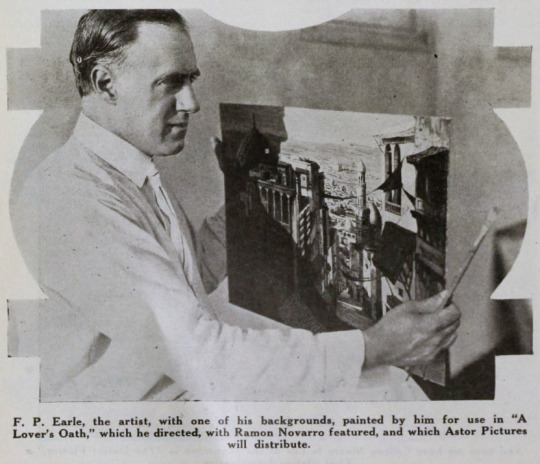

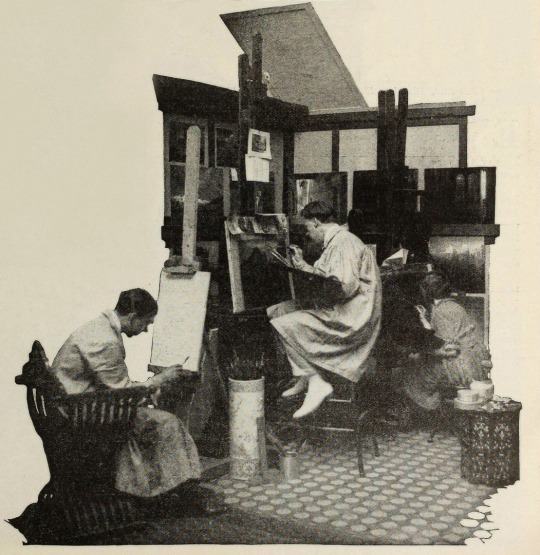
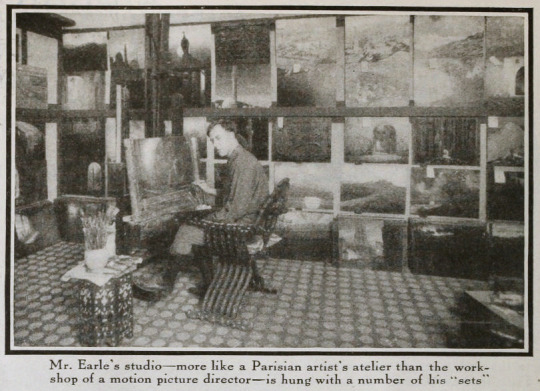
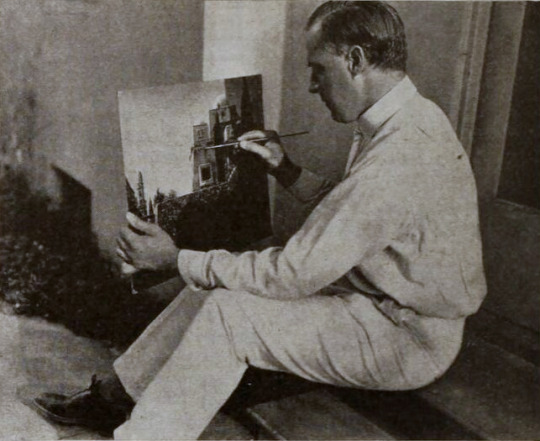
Points of Interest:
“The screen has been described as the last word in realism, but why confine it there? It can also be the last word in imaginative expression.”
Ferdinand P. Earle as quoted in Exhibitors Trade Review, 4 March 1922
The Rubaiyat of Omar Khayyam was a massive best seller. Ferdinand Pinney Earle was a classically trained artist who studied under William-Adolphe Bougueraeu and James McNeill Whistler in his youth. He also had years of experience creating art backgrounds, matte paintings, and art titles for films. Charles Wakefield Cadman was an accomplished composer of songs, operas, and operettas. Georges Benoit and Gordon Pollock were experienced photographic technicians. Edward S. Curtis was a widely renowned still photographer. Ramon Novarro was a name nobody knew yet—but they would soon enough.
When Earle chose The Rubaiyat as the source material for his directorial debut and collected such skilled collaborators, it seemed likely that the resulting film would be a landmark in the art of American cinema. Quite a few people who saw Earle’s Rubaiyat truly thought it would be:
William E. Wing writing for Camera, 9 September 1922, wrote:
“Mr. Earle…came from the world of brush and canvass, to spread his art upon the greater screen. He created a new Rubaiyat with such spiritual colors, that they swayed.” … “It has been my fortune to see some of the most wonderful sets that this Old Earth possesses, but I may truly say that none seized me more suddenly, or broke with greater, sudden inspiration upon the view and the brain, than some of Ferdinand Earle’s backgrounds, in his Rubaiyat. “His vision and inspired art seem to promise something bigger and better for the future screen.”
As quoted in an ad in Film Year Book, 1923:
“Ferdinand Earle has set a new standard of production to live up to.”
Rex Ingram
“Fifty years ahead of the time.”
Marshall Neilan
The film was also listed among Fritz Lang’s Siegfried, Chaplin’s Gold Rush, Fairbanks’ Don Q, Lon Chaney’s Phantom of the Opera and The Unholy Three, and Erich Von Stroheim’s Merry Widow by the National Board of Review as an exceptional film of 1925.
So why don’t we all know about this film? (Spoiler: it’s not just because it’s lost!)
The short answer is that multiple dubious legal challenges arose that prevented Omar’s general release in the US. The long answer follows BELOW THE JUMP!
Earle began the project in earnest in 1919. Committing The Rubaiyat to film was an ambitious undertaking for a first-time director and Earle was striking out at a time when the American film industry was developing an inferiority complex about the level of artistry in their creative output. Earle was one of a number of artists in the film colony who were going independent of the emergent studio system for greater protections of their creative freedoms.
In their adaptation of The Rubaiyat of Omar Khayyam, Earle and Co. hoped to develop new and perfect existing techniques for incorporating live-action performers with paintings and expand the idea of what could be accomplished with photographic effects in filmmaking. The Rubaiyat was an inspired choice. It’s not a narrative, but a collection of poetry. This gave Earle the opportunity to intersperse fantastical, poetic sequences throughout a story set in the lifetime of Omar Khayyam, the credited writer of the poems. In addition to the fantastic, Earle’s team would recreate 12th century Persia for the screen.
Earle was convinced that if his methods were perfected, it wouldn’t matter when or where a scene was set, it would not just be possible but practical to put on film. For The Rubaiyat, the majority of shooting was done against black velvet and various matte photography and multiple exposure techniques were employed to bring a setting 800+ years in the past and 1000s of miles removed to life before a camera in a cottage in Los Angeles.
Note: If you’d like to learn a bit more about how these effects were executed at the time, see the first installment of How’d They Do That.
Unfortunately, the few surviving minutes don’t feature much of this special photography, but what does survive looks exquisite:
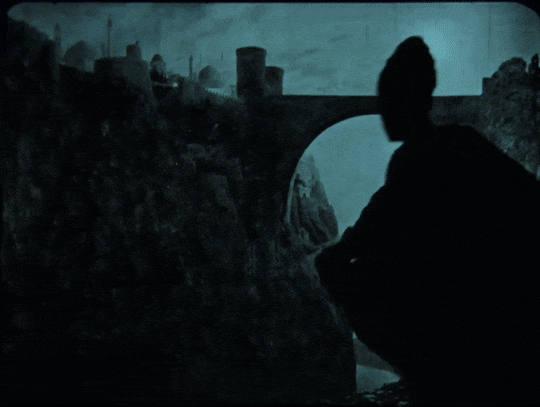
see all gifs here
Earle, knowing that traditional stills could not be taken while filming, brought in Edward S. Curtis. Curtis developed techniques in still photography to replicate the look of the photographic effects used for the film. So, even though the film hasn’t survived, we have some pretty great looking representations of some of the 1000s of missing feet of the film.
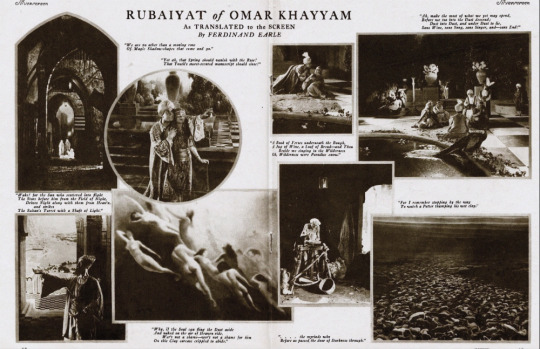
Nearly a year before Curtis joined the crew, Earle began collaboration with composer Charles Wakefield Cadman. In another bold creative move, Cadman and Earle worked closely before principal photography began so that the score could inform the construction and rhythm of the film and vice versa.
By the end of 1921 the film was complete. After roughly 9 months and the creation of over 500 paintings, The Rubaiyat was almost ready to meet its public. However, the investors in The Rubaiyat, Inc., the corporation formed by Earle to produce the film, objected to the ample reference to wine drinking (a comical objection if you’ve read the poems) and wanted the roles of the young lovers (played by as yet unknown Ramon Novarro and Kathleen Key) to be expanded. The dispute with Earle became so heated that the financiers absconded with the bulk of the film to New York. Earle filed suit against them in December to prevent them from screening their butchered and incomplete cut. Cadman supported Earle by withholding the use of his score for the film.
Later, Eastern Film Corp. brokered a settlement between the two parties, where Earle would get final cut of the film and Eastern would handle its release. Earle and Eastern agreed to change the title from The Rubaiyat of Omar Khayyam to simply Omar. Omar had its first official preview in New York City. It was tentatively announced that the film would have a wide release in the autumn.
However, before that autumn, director Norman Dawn launched a dubious patent-infringement suit against Earle and others. Dawn claimed that he owned the sole right to use multiple exposures, glass painting for single exposure, and other techniques that involved combining live action with paintings. All the cited techniques had been widespread in the film industry for a decade already and eventually and expectedly Dawn lost the suit. Despite Earle’s victory, the suit effectively put the kibosh on Omar’s release in the US.
Earle moved on to other projects that didn’t come to fruition, like a Theda Bara film and a frankly amazing sounding collaboration with Cadman to craft a silent-film opera of Faust. Omar did finally get a release, albeit only in Australia. Australian news outlets praised the film as highly as those few lucky attendees of the American preview screenings did. The narrative was described as not especially original, but that it was good enough in view of the film’s artistry and its imaginative “visual phenomena” and the precision of its technical achievement.
One reviewer for The Register, Adelaide, SA, wrote:
“It seems almost an impossibility to make a connected story out of the short verse of the Persian of old, yet the producer of this classic of the screen… has succeeded in providing an entertainment that would scarcely have been considered possible. From first to last the story grips with its very dramatic intensity.”
While Omar’s American release was still in limbo, “Ramon Samaniegos” made a huge impression in Rex Ingram’s Prisoner of Zenda (1922, extant) and Scaramouche (1923, extant) and took on a new name: Ramon Novarro. Excitement was mounting for Novarro’s next big role as the lead in the epic Ben-Hur (1925, extant) and the Omar project was re-vivified.
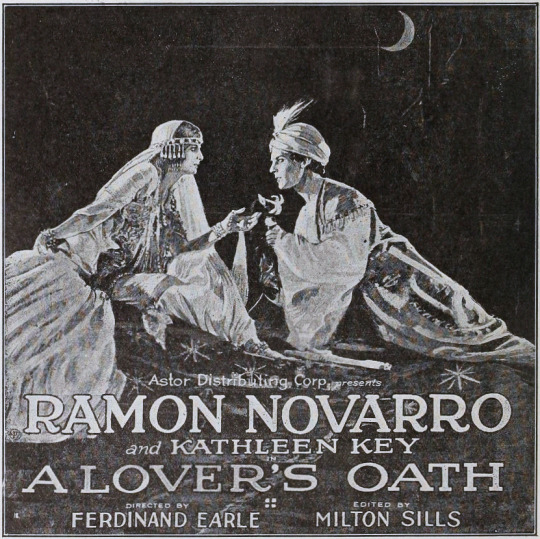
A new company, Astor Distribution Corp., was formed and purchased the distribution rights to Omar. Astor hired actor (note, not an editor) Milton Sills to re-cut the film to make Novarro and Key more prominent. The company also re-wrote the intertitles, reduced the films runtime by more than ten minutes, and renamed the film A Lover’s Oath. Earle had moved on by this point, vowing to never direct again. In fact, Earle was indirectly working with Novarro and Key again at the time, as an art director on Ben-Hur!
Despite Omar’s seemingly auspicious start in 1920, it was only released in the US on the states rights market as a cash-in on the success of one of its actors in a re-cut form five years later.
That said, A Lover’s Oath still received some good reviews from those who did manage to see it. Most of the negative criticism went to the story, intertitles, and Sills’ editing.
What kind of legacy could/should Omar have had? I’m obviously limited in my speculation by the fact that the film is lost, but there are a few key facts about the film’s production, release, and timing to consider.
The production budget was stated to be $174,735. That is equivalent to $3,246,994.83 in 2024 dollars. That is a lot of money, but since the production was years long and Omar was a period film set in a remote locale and features fantastical special effects sequences, it’s a modest budget. For contemporary perspective, Robin Hood (1922, extant) cost just under a million dollars to produce and Thief of Bagdad (1924, extant) cost over a million. For a film similarly steeped in spectacle to have nearly 1/10th of the budget is really very noteworthy. And, perhaps if the film had ever had a proper release in the US—in Earle’s intended form (that is to say, not the Sills cut)—Omar may have made as big of a splash as other epics.
It’s worth noting here however that there are a number of instances in contemporary trade and fan magazines where journalists off-handedly make this filmmaking experiment about undermining union workers. Essentially implying that that value of Earle’s method would be to continue production when unionized workers were striking. I’m sure that that would absolutely be a primary thought for studio heads, but it certainly wasn’t Earle’s motivation. Often when Earle talks about the method, he focuses on being able to film things that were previously impossible or impracticable to film. Driving down filming costs from Earle’s perspective was more about highlighting the artistry of his own specialty in lieu of other, more demanding and time-consuming approaches, like location shooting.
This divide between artists and studio decision makers is still at issue in the American film and television industry. Studio heads with billion dollar salaries constantly try to subvert unions of skilled professionals by pursuing (as yet) non-unionized labor. The technical developments of the past century have made Earle’s approach easier to implement. However, just because you don’t have to do quite as much math, or time an actor’s movements to a metronome, does not mean that filming a combination of painted/animated and live-action elements does not involve skilled labor.
VFX artists and animators are underappreciated and underpaid. In every new movie or TV show you watch there’s scads of VFX work done even in films/shows that have mundane, realistic settings. So, if you love a film or TV show, take the effort to appreciate the work of the humans who made it, even if their work was so good you didn’t notice it was done. And, if you’ve somehow read this far, and are so out of the loop about modern filmmaking, Disney’s “live-action” remakes are animated films, but they’ve just finagled ways to circumvent unions and low-key delegitimize the skilled labor of VFX artists and animators in the eyes of the viewing public. Don’t fall for it.
VFX workers in North America have a union under IATSE, but it’s still developing as a union and Marvel & Disney workers only voted to unionize in the autumn of 2023. The Animation Guild (TAG), also under the IATSE umbrella, has a longer history, but it’s been growing rapidly in the past year. A strike might be upcoming this year for TAG, so keep an eye out and remember to support striking workers and don’t cross picket lines, be they physical or digital!
Speaking of artistry over cost-cutting, I began this post with a mention that in the early 1920s, the American film industry was developing an inferiority complex in regard to its own artistry. This was in comparison to the European industries, Germany’s being the largest at the time. It’s frustrating to look back at this period and see acceptance of the opinion that American filmmakers weren’t bringing art to film. While yes, the emergent studio system was highly capitalistic and commercial, that does not mean the American industry was devoid of home-grown artists.
United Artists was formed in 1919 by Douglas Fairbanks, Charlie Chaplin, Mary Pickford, and D.W. Griffith precisely because studios were holding them back from investing in their art—within the same year that Earle began his Omar project. While salaries and unforgiving production schedules were also paramount concerns in the filmmakers going independent, a primary impetus was that production/distribution heads exhibited too much control over what the artists were trying to create.
Fairbanks was quickly expanding his repertoire in a more classical and fantastic direction. Cecil B. DeMille made his first in a long and very successful string of ancient epics. And the foreign-born children of the American film industry, Charlie Chaplin, Rex Ingram, and Nazimova, were poppin’ off! Chaplin was redefining comedic filmmaking. Ingram was redefining epics. Nazimova independently produced what is often regarded as America’s first art film, Salome (1923, extant), a film designed by Natacha Rambova, who was *gasp* American. Earle and his brother, William, had ambitious artistic visions of what could be done in the American industry and they also had to self-produce to get their work done.
Meanwhile, studio heads, instead of investing in the artists they already had contracts with, tried to poach talent from Europe with mixed success (in this period, see: Ernst Lubitsch, F.W. Murnau, Benjamin Christensen, Mauritz Stiller, Victor Sjöström, and so on). I’m in no way saying it was the wrong call to sign these artists, but all of these filmmakers, even if they found success in America, had stories of being hired to inject the style and artistry that they developed in Europe into American cinema, and then had their plans shot down or cut down to a shadow of their creative vision. Even Stiller, who tragically died before he had the opportunity to establish himself in the US, faced this on his first American film, The Temptress (1926, extant), on which he was replaced. Essentially, the studio heads’ actions were all hot air and spite for the filmmakers who’d gone independent.
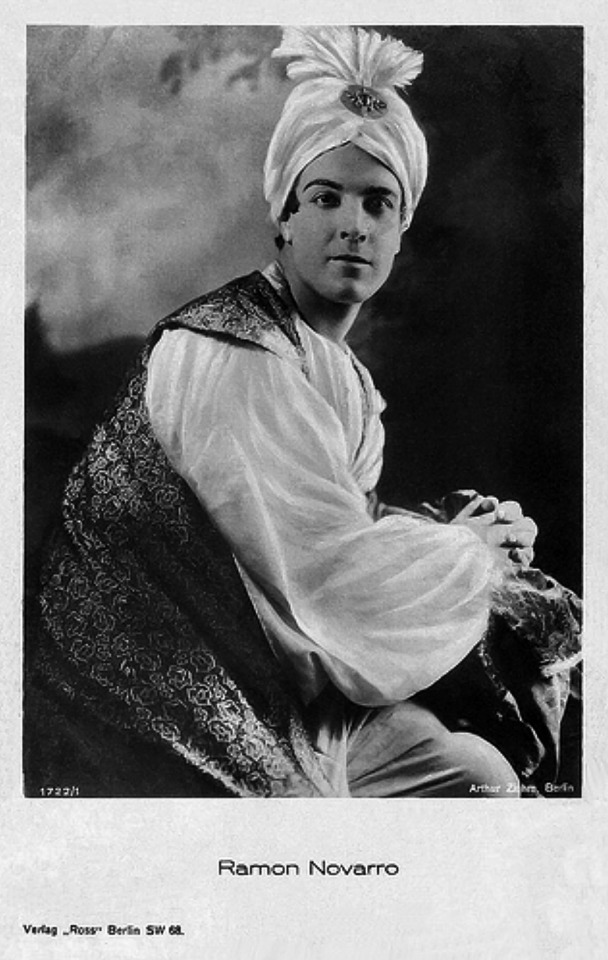
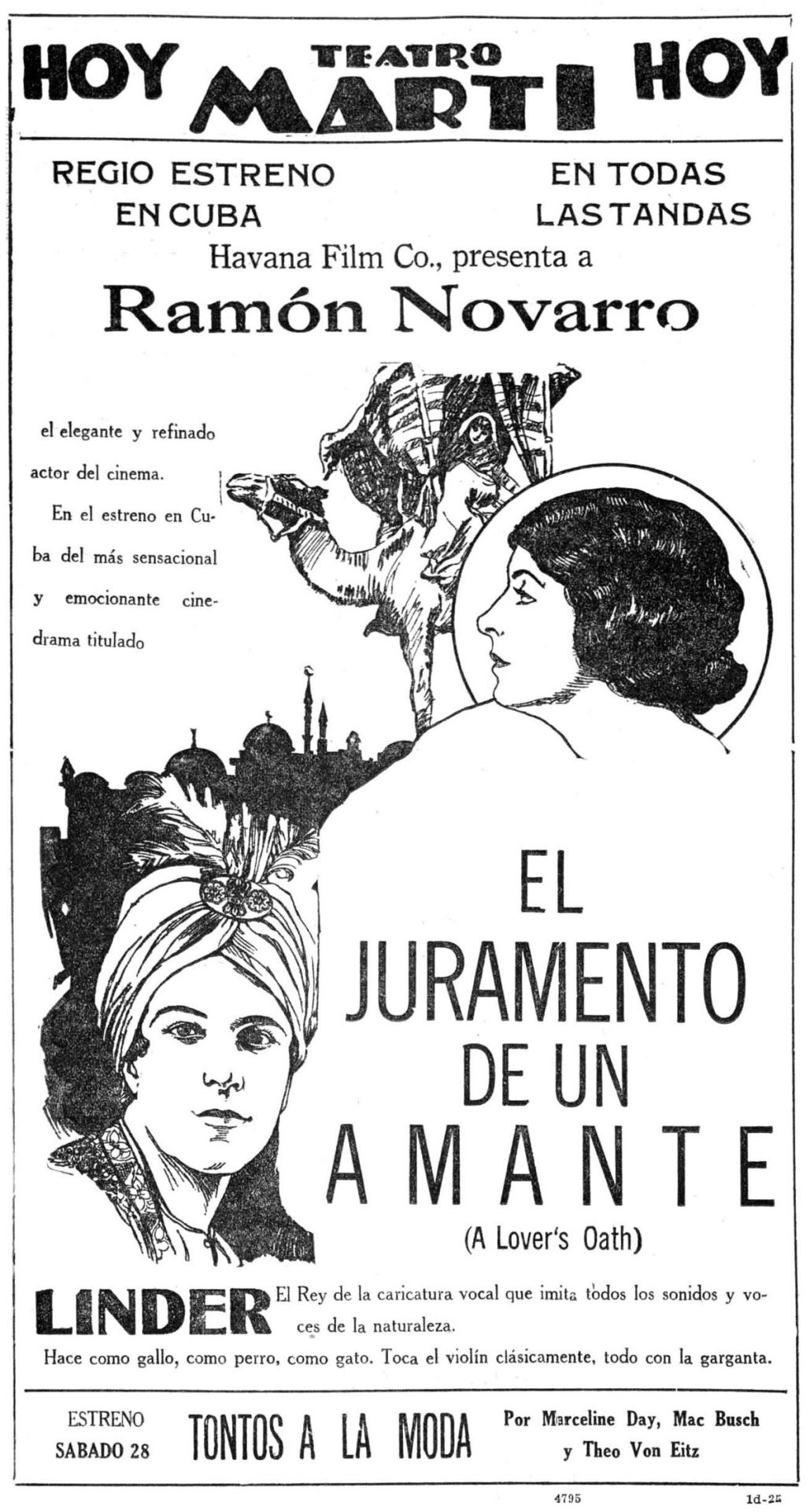
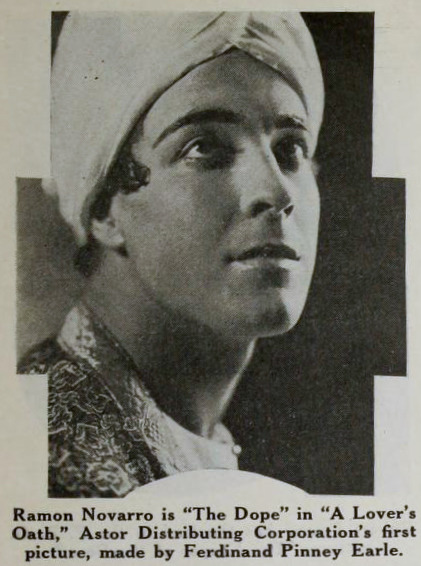
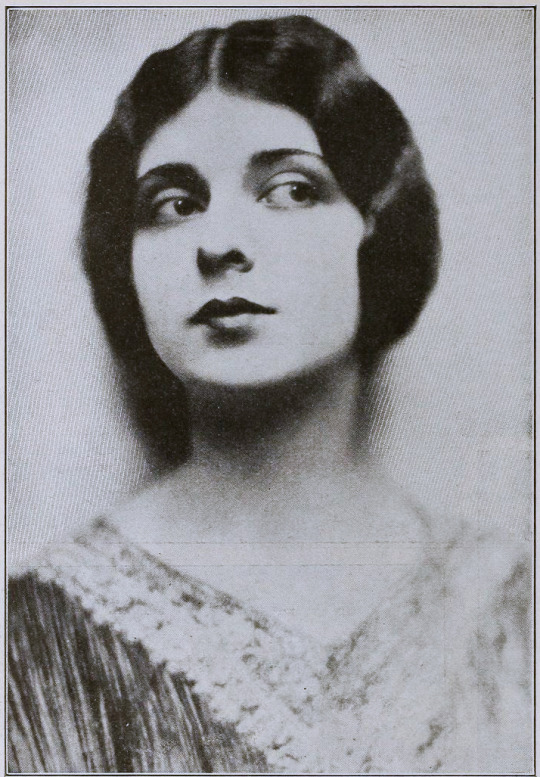

Finally I would like to highlight Ferdinand Earle’s statement to the industry, which he penned for from Camera in 14 January 1922, when his financial backers kidnapped his film to re-edit it on their terms:
MAGNA CHARTA
Until screen authors and producers obtain a charter specifying and guaranteeing their privileges and rights, the great slaughter of unprotected motion picture dramas will go merrily on.
Some of us who are half artists and half fighters and who are ready to expend ninety per cent of our energy in order to win the freedom to devote the remaining ten per cent to creative work on the screen, manage to bring to birth a piteous, half-starved art progeny.
The creative artist today labors without the stimulus of a public eager for his product, labors without the artistic momentum that fires the artist’s imagination and spurs his efforts as in any great art era.
Nowadays the taint of commercialism infects the seven arts, and the art pioneer meets with constant petty worries and handicaps.
Only once in a blue moon, in this matter-of-fact, dollar-wise age can the believer in better pictures hope to participate in a truely [sic] artistic treat.
In the seven years I have devoted to the screen, I have witnessed many splendid photodramas ruined by intruding upstarts and stubborn imbeciles. And I determined not to launch the production of my Opus No. 1 until I had adequately protected myself against all the usual evils of the way, especially as I was to make an entirely new type of picture.
In order that my film verison [sic] of the Rubaiyat of Omar Khayyam might be produced under ideal conditions and safeguarded from intolerable interferences and outside worries, I entered into a contract with the Rubaiyat, Inc., that made me not only president of the corporation and on the board of directors, but which set forth that I was to be author, production manager, director, cutter and film editor as well as art director, and that no charge could be made against the production without my written consent, and that my word was to be final on all matters of production. The late George Loane Tucker helped my attorney word the contract, which read like a splendid document.
Alas, I am now told that only by keeping title to a production until it is declared by yourself to be completed is it safe for a scenario writer, an actor or a director, who is supposedly making his own productions, to contract with a corporation; otherwise he is merely the servant of that corporation, subject at any moment to discharge, with the dubious redress of a suit for damages that can with difficulty be estimated and proven.
Can there be any hope of better pictures as long as contracts and copyrights are no protection against financial brigands and bullies?
We have scarcely emerged from barbarism, for contracts, solemnly drawn up between human beings, in which the purposes are set forth in the King’s plainest English, serve only as hurdles over which justice-mocking financiers and their nimble attorneys travel with impunity, riding rough shod over the author or artist who cannot support a legal army to defend his rights. The phrase is passed about that no contract is invioliable [sic]—and yet we think we have reached a state of civilization!
The suit begun by my attorneys in the federal courts to prevent the present hashed and incomplete version of my story from being released and exhibited, may be of interest to screen writers. For the whole struggle revolves not in the slightest degree around the sanctity of the contract, but centers around the federal copyright of my story which I never transferred in writing otherwise, and which is being brazenly ignored.
Imagine my production without pictorial titles: and imagine “The Rubaiyat” with a spoken title as follows, “That bird is getting to talk too much!”—beside some of the immortal quatrains of Fitzgerald!
One weapon, fortunately, remains for the militant art creator, when all is gone save his dignity and his sense of humor; and that is the rapier blade of ridicule, that can send lumbering to his retreat the most brutal and elephant-hided lord of finance.
How edifying—the tableau of the man of millions playing legal pranks upon men such as Charles Wakefield Cadman, Edward S. Curtis and myself and others who were associated in the bloody venture of picturizing the Rubaiyat! It has been gratifying to find the press of the whole country ready to champion the artist’s cause.
When the artist forges his plowshare into a sword, so to speak, he does not always put up a mean fight.
What publisher would dare to rewrite a sonnet of John Keats or alter one chord of a Chopin ballade?
Creative art of a high order will become possible on the screen only when the rights of established, independent screen producers, such as Rex Ingram and Maurice Tourneur, are no longer interferred with and their work no longer mutilated or changed or added to by vandal hands. And art dramas, conceived and executed by masters of screen craft, cannot be turned out like sausages made by factory hands. A flavor of individuality and distinction of style cannot be preserved in machine-made melodramas—a drama that is passed from hand to hand and concocted by patchworkers and tinkerers.
A thousand times no! For it will always be cousin to the sausage, and be like all other—sausages.
The scenes of a master’s drama may have a subtle pictorial continuity and a power of suggestion quite like a melody that is lost when just one note is changed. And the public is the only test of what is eternally true or false. What right have two or three people to deprive millions of art lovers of enjoying an artist’s creation as it emerged from his workshop?
“The Rubaiyat” was my first picture and produced in spite of continual and infernal interferences. It has taught me several sad lessons, which I have endeavored in the above paragraphs to pass on to some of my fellow sufferers. It is the hope that I am fighting, to a certain extent, their battle that has given me the courage to continue, and that has prompted me to write this article. May such hubbubs eventually teach or inforce a decent regard for the rights of authors and directors and tend to make the existence of screen artisans more secure and soothing to the nerves.
FERDINAND EARLE.
---
☕Appreciate my work? Buy me a coffee! ☕
Transcribed Sources & Annotations over on the WMM Blog!
See the Timeline for Ferdinand P. Earle's Rubaiyat Adaptation
#1920s#1923#1925#omar khayyam#ferdinand pinney earle#ramon novarro#independent film#american film#silent cinema#silent era#silent film#classic cinema#classic movies#classic film#film history#history#Charles Wakefield Cadman#cinematography#The Rubaiyat#cinema#film#lost film
49 notes
·
View notes
Text
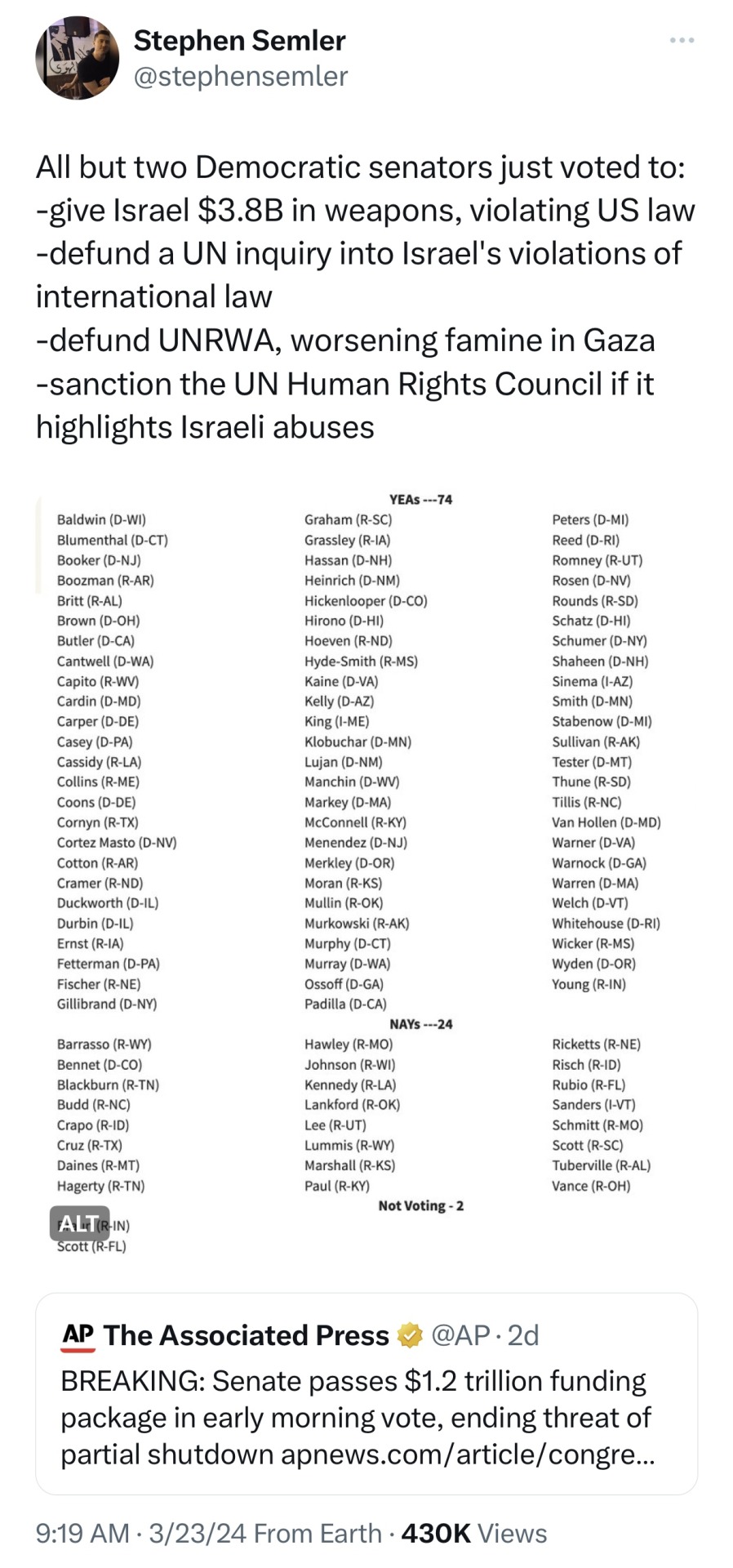
Source
[ID: a quote tweet by Stephen Semler (@stephensemler) dated March 23, 2024. It is responding to a tweet by the Associated Press (@AP) that says, “BREAKING: Senate passes $1.2 trillion funding package in early morning vote, ending threat of partial shutdown.”
It says, “All but two Democratic senators just voted to:
-give Israel $3.8B in weapons, violating US law
-defund a UN inquiry into Israel's violations of international law
-defund UNRWA, worsening famine in Gaza
-sanction the UN Human Rights Council if it highlights Israeli abuses.”
It contains an image of only text showing who voted yea, who voted nay, and who abstained. 74 senators voted yea, including 47 democrats, 25 republicans, and 2 independents. 24 senators voted nay: all republicans except Senator Bennet (Democrat, Colorado), and Senator Sanders (Independent, Vermont). 2 Republican senators abstained. Full transcription of this image under the cut.]
Transcript of the image contained in the tweet:
“YEAS --- 74
Baldwin (D-WI)
Blumenthal (D-CT)
Booker (D-NJ)
Boozman (R-AR)
Britt (R-AL)
Brown (D-OH)
Butler (D-CA)
Cantwell (D-WA)
Capito (R-WV)
Cardin (D-MD)
Carper (D-DE)
Casey (D-PA)
Cassidy (R-LA)
Collins (R-ME)
Coons (D-DE)
Cornyn (R-TX)
Cortez Masto (D-NV)
Cotton (R-AR)
Cramer (R-ND)
Duckworth (D-IL)
Durbin (D-IL)
Ernst (R-IA)
Fetterman (D-PA)
Fischer (R-NE)
Gillibrand (D-NY)
Graham (R-SC)
Grassley (R-IA)
Hassan (D-NH)
Heinrich (D-NM)
Hickenlooper (D-CO)
Hirono (D-HI)
Hoeven (R-ND)
Hyde-Smith (R-MS)
Kaine (D-VA)
Kelly (D-AZ)
King (1-ME)
Klobuchar (D-MN)
Lujan (D-NM)
Manchin (D-WV)
Markey (D-MA)
McConnell (R-KY)
Menendez (D-NJ)
Merkley (D-OR)
Moran (R-KS)
Mullin (R-OK)
Murkowski (R-AK)
Murphy (D-CT)
Murray (D-WA)
Ossoff (D-GA)
Padilla (D-CA)
Peters (D-MI)
Reed (D-RI)
Romney (R-UT)
Rosen (D-NV)
Rounds (R-SD)
Schatz (D-HI)
Schumer (D-NY)
Shaheen (D-NH)
Sinema (I-AZ)
Smith (D-MN)
Stabenow (D-MI)
Sullivan (R-AK)
Tester (D-MT)
Thune (R-SD)
Tillis (R-NC)
Van Hollen (D-MD)
Warner (D-VA)
Warnock (D-GA)
Warren (D-MA)
Welch (D-VT)
Whitehouse (D-RI)
Wicker (R-MS)
Wyden (D-OR)
Young (R-IN)
(This is the end of the yeas.)
NAYS --- 24
Barrasso (R-WY)
Bennet (D-CO)
Blackburn (R-TN)
Budd (R-NC)
Crapo (R-ID)
Cruz (R-TX)
Daines (R-MT)
Hagerty (R-TN)
Hawley (R-MO)
Johnson (R-WI)
Kennedy (R-LA)
Lankford (R-OK)
Lee (R-UT)
Lummis (R-WY)
Marshall (R-KS)
Paul (R-KY)
Ricketts (R-NE)
Risch (R-ID)
Rubio (R-FL)
Sanders (I-VT)
Schmitt (R-MO)
Scott (R-SC)
Tuberville (R-AL)
Vance (R-OH)
(This is the end of the nays.)
Not Voting - 2
Braun (R-IN)
Scott (R-FL)”
(This is the end of the transcribed image.)
#palestine#free palestine#gaza#gaza strip#free gaza#israel#palestinian genocide#unrwa#us politics#genocide joe#genocidin biden#democrats#blue maga#vote blue no matter who#human rights violations#international law#cross posted from twitter#twitter#my post#original post#(but not really)#this post was queued
34 notes
·
View notes
Text
Episode 31 - Darkness in the Valley has just gone live wherever you get your podcasts!
This episode features Ashanti Robinson, Paul Warren, @totcoc0a, @just-jessie-d, Michelle Kelly, Elyjah Phillips, and Zoe Lee
5 notes
·
View notes
Text

#1 fly boy flyboy new hot songs bosshogg fast life thug boss chamilli Mixtape Messiah records Lizard Killa snoop timbaland rihanna t-pain t.i ne-yo akon lil wayne rihanna linkin park 50 cent maroon 5 ice cube the game akon lil wayne rihanna 50 cent linkin park maroon 5 daddy yankee hichem & iman gorilla zoe lil wayne akon t-pain maroon 5 50 cent rihanna nas linkin park madona britney spears shakira kelly rowland r.kelly daddy yankee don omar wisin yandel lil wayne nelly rick ross dj khaled fat joe trick daddy pitbull plies flo rida elevator low t-pain bloods new york wagton harlem Lil wayne lollipop Kanye West rap r&b t-pain official remix full length lil wayne kanye west weezy lollipop remix rap r&b hip-hop world music indie unsigne Lollipop Lil Wayne Gucci Mane REMIX d carter graduation Lil Wayne Lollipop [Uncensored] hip-hop r&b rap Lil Wayne Kanye West lollipop remix official tha carter gucci mane official remix full length afropik.com afropik music Jay-Z - Blow The Whistle (EXCLUSIVE) !!!NEW!!! Hip-Hop Rap Jay-Z Blow The Whistle DeShawn Stevenson Diss Roc Boys Blue Magic American Gangster Kingdom Come 99 Problems Big pimpin Encore Remix The Blueprint Rocafella New Jay-Z diss to Deshawn Stevenson i7pimuziktv, aka "LeBron is Overrated" lebron james Makaveli 2Pac Tupac The outlaws Ice Cube Snoop Dogg NWA Eazy E Tha Dogg Pound Dr.dre G-Unit 50 Cent Eminem How We Do Hate It or Love It Put You in the Game Dreams Stop Snitchin, Stop Lyin' Westside Story Let's Ride Wouldn't Get Far It's Okay One Blood Remix DISS TRACKS 2PAC HIT'Em UP hip-hop r&b rap Three 6 Mafia DJ UNK I'd Rather Official Video Most Known Unknown Last 2 Walk Stay Fly Side 2 Side Crunk Music Dirty South Lil Jon Lil Flip Young Buck Slim Thug, Trick Daddy, & Project Pat Mike Jones & Paul Wall 8 Ball & MJG Project Pat, Lil Wyte, Akon, Good Charlotte, DJ Unk, Lyfe Jennings, UGK, Eightball & MJG, Al Kapone, DJ Spanish Fly, Frayser Boy, Chrome, Yung D, Superpower, and more DJ Paul and Juicy J G-Unit - Like A Dog (Official Video) !!NEW!! G-Unit - Hollow Thru Him (Fat Joe Diss) Elephant In The Sand G-Unit - Aim (Fat Joe Diss) [NEW TRACK] G-UNIT GUNIT G UNIT UNIT UNOT ROTTEN APPLE BUCK THE WORLD SOUTHSIDE IM LEAVIN' LEAVING FAT JOE PUSSY BOY NEW SUNROOF SUN ROOF OPEN THE MECHANIC BE GOOD TO ME 50 CENT TONY YAYO LLOYD BANKS YOUNG BUCK G-UNIT GUNIT THISIS50.COM GUNIWORLD.COM G-UNITMEDIA.AT.GG CENTS UNOT G- OT GAME NAS JA RULE FAT JOE LIL WAYNE FAKE hiphop hip hop dance krump rap soulja boy crank that huey kanye fergie ciara 50cent rihanna beyonce Urban Music News Pop Rihanna Lil Mama Jay-Z Ne-Yo Good Girl Gone Bad l mama chris brown tpain t-pain shawty shorty get loose low flo rida with you kiss bet dance michael jackson Ludacris ft Young Jeezy - Grew Up A Screw Up Ludacris ft Young Jeezy - Grew Up A Screw Up (Chopped and Screwed) ludacris young jeezy grew screw sinxation chellorose Ludacris Feat Young Jeezy Ludacris Ft. Young Jeezy - Grew Up A Screw Up. Uncensored.a music video remastered by me grew up a screw up hope you enjoy ludacris youngjeezy grewupascarewup grew young jeezy T-pain lil' mama lil mama chris brown tpain t-pain shawty shorty get looida with nce michael jackson Dj Paul Juicy j Project Pat Lil Wyte Cut Mixtape Gorilla Zoe pussy cat dolls pussycat dolls beyonce britney spears rihanna danity kane lady gaga chris brownfergie christina aguilera nicole scherzinger pink akon lil wayne mariah carey shakira buttons ciara girlicious miley cyrus taylor swift black eyed peas justin timberlake poker face soulja boy katy perry disturbia beep just dance usher kelly clarkson womanizer the pussycat dolls avril lavigne eminem nelly furtado hannah montana jonas brothers boom boom pow pussy cat dools carrie underwood beyonce single ladies pussy cat doll paramore leona lewis neyo keri hilson dont cha pcd bottle pop single ladies sean paul pussy cat dols michael jackson madonna flo rida spice girls prima j pitbull stick with you britney spears circus jojo ashanti rihanna disturbia pussycatdolls danity kane damaged ashley tisdale
6 notes
·
View notes
Text







Original program of THE FATHER, Grace Kelly's debut on Broadway. Playbill, 01/02/50, Cort Theatre, NYC. The revival of the August Strindberg play opened in NYC on 11/16/49 and ran for only 69 performances. The cast includes Raymond Massey, Mady Christians, Mary Morris, Philip Huston, John D. Seymour, Grace Kelly (Broadway debut), Paul Larson and Charles Snyder. Directed by Raymond Massey.
From eBay.
#grace kelly#princess grace#the father#1950#cort theatre#new york#1949#raymond massey#mady christians
8 notes
·
View notes
Text

Charlie, Kelly and Paul flashback versions, in Charlie's apartment :D You will never be able to convince me that they are evil and narcissistic! For me, they are all sweet and kind buns with raisins!
#charlie murder#ska studios#ska studios charlie murder#charlie murder kelly#charlie murder fanart#Charlie Murder flashback#Charlie Murder Paul
9 notes
·
View notes